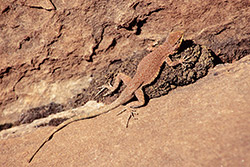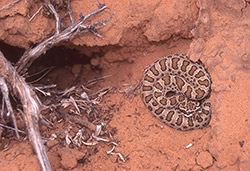Reptiles are the quintessential desert creature. Adapted to warm temperatures and dry conditions, these ectotherms (animals dependent upon external heat) include lizards and snakes. These modern-day reptiles are linked to the dinosaurs who ruled the planet during the Age of Reptiles (the Mesozoic Era), from 350-66 million years ago.
 Today, the Canyonlands region is home to numerous species of lizards and snakes. Their presence elicits various degrees of excitement and curiosity. Just remember to keep that wonder at a distance and enjoy these scaled-down versions of their prehistoric ancestors.
Today, the Canyonlands region is home to numerous species of lizards and snakes. Their presence elicits various degrees of excitement and curiosity. Just remember to keep that wonder at a distance and enjoy these scaled-down versions of their prehistoric ancestors.
The most common lizard hikers may encounter is the small side-blotched lizard which is tannish-brown in color with dark “armpits’; hence, the common name. These lizards feed on small insects, and because of their small size, emerge early in the spring as the temperatures warm up. In fact, you may see these lizards out foraging on warm winter days since it doesn’t take much for them to heat up. The downside of being a small lizard is that they become prey for larger lizards, snakes, and other predators.
Another common insect-eating lizard is the western whiptail with its long whip-like tail and slender body. These lizards also eat grasshoppers, beetles, scorpions, spiders, ants, and Lepidoptera – butterflies and moths. Fast-moving, these lizards are fun to watch scurrying after prey. Like other lizards, the whiptail’s tail can disconnect (disarticulate) from its body if a predator grabs ahold of it. When disconnected, the tail continues to contract making the appendage look “alive” which allows the lizard time to escape. Though they can regrow their tails, this disarticulation comes at an energy loss. This is one of the prime reasons to avoid trying to catch a lizard. That, and you might get bitten.
The largest lizards in the region are the leopard lizard and collared lizard. Named after the spots on its body and its stout snout, the long-nosed leopard lizard may show orange spotting on its side as this is a signal that the female lizard is ready to be bred (gravid).
But of all the lizards, the colorful collared lizard wins the prize for the most spectacular reptile. Its yellow head, two dark neck collars, and turquoise-colored body with yellow bands and white spots is a true sight to behold. And if the collared lizard really feels the need for speed, they can stand up and run on their hind legs (bipedal motion)!
Along with the lizards, snakes also have scaly skin and hatch from eggs. They are another fascinating group of creatures that slither through the desert landscape. Most feared, although less commonly observed, are midget-faded rattlesnakes. Their venomous bite is meant to subdue prey, and these rattlesnakes rarely bite humans unless provoked or handled. The rattlers would rather sound their buzzing warning or slip away beneath the shrubs to avoid confrontations. Sometimes the snakes do not release any venom if they bite a person, but do you really want to test that theory?
The gopher snake is a long yellowish snake with dark-edged spots which often imitates a rattlesnake when threatened. The snake will coil up and flatten its head to mimic a rattlesnake’s posture. Lacking buttons or a rattle on its tail, a threatened snake may still vibrate its tail keeping up the rattlesnake ruse. Like sleeping dogs, leave the snakes alone and all should be well!